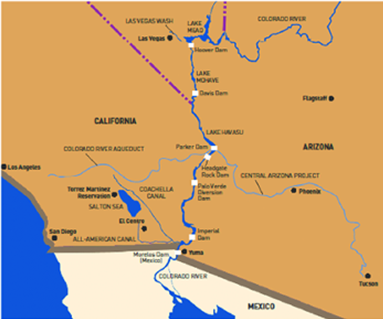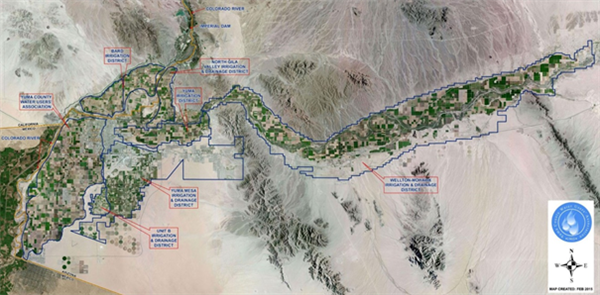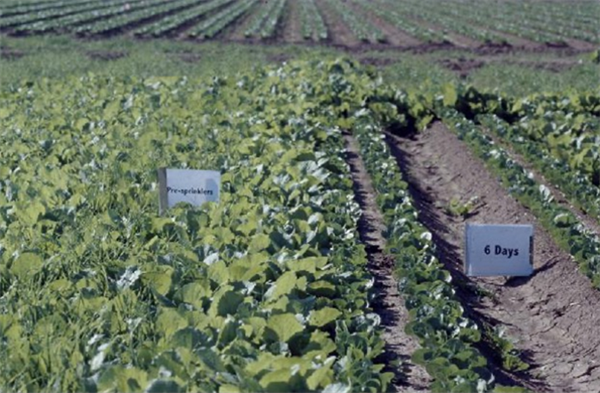
As part of the SW Ag Summit that recently took place in Yuma, we conducted a breakout session on Thursday, 23 February 2023 titled “Colorado River Water Shortage: Agricultural Perspectives”.
This session provided a brief review of the background and current situation on the Colorado River and included perspectives from members of the lower Colorado River agricultural community including the Palo Verde Valley, Imperial Valley, and the Yuma area irrigation districts. The program outline included the following participants:
Colorado River Water Shortage: Introductory Overview
Jeff Silvertooth, University of Arizona, Tucson, AZ
Colorado River Water Shortage: Palo Verde Valley Perspective
Bart Fisher, Fisher Ranch, Blythe, CA
Colorado River Water Shortage: Imperial Valley Perspective
Larry Cox, Lawrence Cox Ranches, Brawley, CA
Colorado River Water Shortage: Yuma Perspective
Elston Grubaugh, Wellton Mohawk Irrigation & Drainage District, Wellton, AZ
Moderator: Jeff Silvertooth
For geographic reference, Figures 1 and 2 provide maps of the lower Colorado River Valley and Yuma agricultural irrigation districts.
The session was not recorded but we do have each of the presentations available in the following links.
Jeff Silvertooth:
https://live-azs-vegetableipmupdates.pantheonsite.io/sites/default/files/2023-02/2023SWAS_JCS SWAS_ColoR Ag Perspectives_23feb23_FINAL_post.pdf
Bart Fisher:
https://live-azs-vegetableipmupdates.pantheonsite.io/sites/default/files/2023-02/2023SWAS_BF_SW%20Ag%20Summit%202023.pdf
Larry Cox:
https://live-azs-vegetableipmupdates.pantheonsite.io/sites/default/files/2023-02/2023SWAS_LC SWAS 23 February 2023.pdf
Elston Grubaugh:
https://live-azs-vegetableipmupdates.pantheonsite.io/sites/default/files/2023-02/2023SWAS_EG_02232023%20SW%20Ag%20Summit%20Panel_0.pdf
Also posted below is the link to an excellent video regarding Yuma Water and Ag that was recently developed and presented on 23 February by the Yuma Fresh Vegetable Association.
www.yumaagwater.com

Figure 1. Map of the lower Colorado River including the dams, diversions,
and some of the major canal systems.

Figure 2. Map of the Yuma area irrigation districts. Source: Yuma Water Users Association, 2015.
This study was conducted at the Yuma Valley Agricultural Center. The soil was a silty clay loam (7-56-37 sand-silt-clay, pH 7.2, O.M. 0.7%). Spinach ‘Meerkat’ was seeded, then sprinkler-irrigated to germinate seed Jan 13, 2025 on beds with 84 in. between bed centers and containing 30 lines of seed per bed. All irrigation water was supplied by sprinkler irrigation. Treatments were replicated four times in a randomized complete block design. Replicate plots consisted of 15 ft lengths of bed separated by 3 ft lengths of nontreated bed. Treatments were applied with a CO2 backpack sprayer that delivered 50 gal/acre at 40 psi to flat-fan nozzles.

Downy mildew (caused by Peronospora farinosa f. sp. spinaciae)was first observed in plots on Mar 5 and final reading was taken on March 6 and March 7, 2025. Spray date for each treatments are listed in excel file with the results.
Disease severity was recorded by determining the percentage of infected leaves present within three 1-ft2areas within each of the four replicate plots per treatment. The number of spinach leaves in a 1-ft2area of bed was approximately 144. The percentage were then changed to 1-10scale, with 1 being 10% infection and 10 being 100% infection.
The data (found in the accompanying Excel file) illustrate the degree of disease reduction obtained by applications of the various tested fungicides. Products that provided most effective control against the disease include Orondis ultra, Zampro, Stargus, Cevya, Eject .Please see table for other treatments with significant disease suppression/control. No phytotoxicity was observed in any of the treatments in this trial.
For those of you interested in the latest thoughts on ag technology, you might want to check out the keynote address given by John Deere1 at CES 2023 earlier this week. The presentation can be found on YouTube at: https://youtu.be/1kjZMHZl538. As you might expect, there is a fair amount of company self-promotion, but it is interesting to hear their view on the current state and future of agricultural technologies. A couple of key takeaways for me were that telematics and computer vision systems will play key roles in the future and that increased precision will continue to be a focus.
[1] Reference to a product or company is for specific information only and does not endorse or recommend that product or company to the exclusion of others that may be suitable.
In the year 2000 Weed scientist and Area Agriculture Agent Barry Tickes from the University of Arizona Yuma Agricultural Center conducted many evaluations to determine the best application method for Pronamide Herbicide (Kerb) in lettuce. His studies revealed that in the low desert the product was losing significant efficacy because it was applied right after planting and before starting sprinkler irrigation. Pronamide is very soluble in water and was often leached below weed seeds prior to their germination.The goal of these projects was to delay the application of the product to have it available at the right time for weed germination. To do this Tickes stopped the sprinkler irrigation at different timings before weed germination and sprayed plots with a CO2 experimental backpack in the mud.
He demonstrated that Kerb applications should be delayed from 1 to 6 days after starting sprinklers depending on the time of the season. Delayed applications at the time were done with aerial applications, but after the terrorist’s attacks 21 years ago all air traffic was suspended. Then PCAs asked if the product could be chemigated (applied through the sprinkler irrigation). To answer this question Tickes conducted several trials in Yuma.
Surprisingly the results revealed that the product performed better chemigated than applied by air. Today most of the Kerb in Arizona is chemigated and applied in delayed applications, also the method is extensively used in California.
It all started with a little trial in a Yuma Experiment Station that demonstrated delayed applications work. Then 9/11created the circumstances that forced the industry to take that course. If you would like to review the original data from this research please visit: Timing Kerb Applications in Lettuce and Evaluation of Kerb Applied by Sprinkler Irrigation to Lettuce both by Barry Tickes.
Timing Kerb Applications in Lettuce

Results of pheromone and sticky trap catches can be viewed here.
Corn earworm: CEW moth counts down in all traps over the last month; about average for December.
Beet armyworm: Moth trap counts decreased in all areas in the last 2 weeks but appear to remain active in some areas, and average for this time of the year.
Cabbage looper: Moths increased in the past 2 weeks, and average for this time of the season.
Diamondback moth: Adults increased in several locations last, particularly in the Yuma Valley most traps. Below average for December.
Whitefly: Adult movement remains low in all areas, consistent with previous years
Thrips: Thrips adult movement continues to decline, overall activity below average for December.
Aphids: Winged aphids still actively moving but declined movement in the last 2 weeks. About average for December.
Leafminers: Adult activity down in most locations, below average for this time of season.